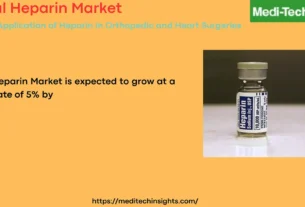
Overview
The global vascular access device (VAD) market is projected to grow steadily at a CAGR of ~6% during the forecast period. The key growth drivers include the rising prevalence of chronic diseases requiring frequent or long-term intravenous therapy, growing preference for minimally invasive procedures, an expanding elderly population, and technological advancements in catheter materials and design. However, the increasing number of catheter-acquired infections continues to challenge market expansion.
Key Request a free sample copy or view report summary: https://meditechinsights.com/vascular-access-device-market/request-sample/
Report Overview
A vascular access device (VAD) is a medical tool inserted into a patient’s vein for the delivery of medications, fluids, blood products, or for drawing blood samples. Common types include central venous catheters, peripheral venous catheters, peripherally inserted central catheters (PICCs), and implanted ports. These devices are essential for managing chronic diseases such as diabetes, cancer, and renal disorders, providing patients with consistent vascular access while reducing the need for repeated needle insertions.
Chronic Disease Burden Driving Demand for Vascular Access Devices
The growing global burden of chronic diseases such as cancer, diabetes, and end-stage renal disease is significantly driving demand for vascular access devices. According to the WHO, approximately 43 million deaths were recorded in 2021, with three out of four caused by noncommunicable diseases. These conditions often require frequent medication administration, long-term therapies such as chemotherapy or insulin, and regular blood sampling. VADs provide a less painful and more reliable alternative to repeated venipunctures, improving patient comfort and treatment efficiency. For instance, implanted ports and PICCs are critical for cancer patients undergoing chemotherapy, enabling safe and repeated delivery of cytotoxic drugs. The demand for vascular access devices is also increasing across acute and home care settings, driven by aging populations and rising hospitalization rates. In November 2023, BD (Becton, Dickinson and Company) launched the SiteRite 9 Ultrasound System to enhance vascular visualization and improve clinician accuracy in placing PICCs, central venous catheters, and IV lines—demonstrating ongoing innovation in this field.
Antimicrobial-coated Catheters: Enhancing Safety and Reducing Infection Risk
The introduction of antimicrobial-coated catheters has greatly enhanced patient safety and reduced infection risks in vascular access. These catheters incorporate antimicrobial agents such as silver sulfadiazine, chlorhexidine, or minocycline-rifampin, which prevent bacterial colonization on catheter surfaces. This innovation effectively lowers the incidence of catheter-related bloodstream infections (CRBSIs), a leading complication of long-term vascular access. Studies have shown a substantial reduction in infection rates and hospital stays when such catheters are used, leading to improved clinical outcomes and cost savings. Their adoption has been further encouraged by regulatory endorsements and inclusion in infection prevention guidelines by institutions such as the CDC. As a result, antimicrobial-coated catheters are increasingly used in hospitals and infusion centers, particularly among immunocompromised and high-risk patients.
Competitive Landscape Analysis
The vascular access device market features strong competition among established and emerging players, including BD, Teleflex Medical, B. Braun, AngioDynamics, ICU Medical, Medtronic, Medical Components Inc., Cook Medical, Terumo Medical Corporation, and Access Vascular Inc. Key strategies adopted by these companies include new product launches, technological innovation, strategic collaborations, and geographic expansion to strengthen market presence.
The vascular access device market is witnessing notable expansion, driven by several key factors influencing the global healthcare landscape. One of the primary market drivers is the rising prevalence of chronic diseases such as cancer, diabetes, and kidney disorders that often require long-term intravenous (IV) therapy for medication administration, nutrition, or chemotherapy. Alongside this, the rapid growth of the geriatric population—which is more susceptible to chronic conditions and hospitalization—has significantly increased the demand for vascular access devices. Additionally, the growing need for long-term IV therapy in managing complex medical conditions, coupled with the rising number of hospital admissions and surgical procedures, continues to boost product utilization across hospitals, clinics, and home care settings.
Another important factor contributing to market growth is the increasing demand for minimally invasive treatment delivery methods that enhance patient comfort and reduce complications. Technological advancements in catheter materials and design, including the use of biocompatible and antimicrobial coatings, have further improved safety, durability, and ease of insertion, strengthening market adoption worldwide.
Beyond these growth drivers, the market presents several attractive opportunities for innovation and expansion. The rising trend of home-based care and infusion therapy is creating new avenues for convenient and cost-effective treatment outside traditional hospital environments. Furthermore, emerging markets across Asia-Pacific, Latin America, and the Middle East are witnessing rapid improvements in healthcare infrastructure, making them highly lucrative regions for market entry and growth. Increasing preference for peripherally inserted central catheters (PICCs) and midline catheters due to their efficiency and reduced infection risks also adds momentum. In addition, ongoing development of pressure-resistant and power-injectable catheters tailored for advanced diagnostic and therapeutic use is likely to redefine clinical practices and support long-term market expansion in the coming years.
Browse Report: https://meditechinsights.com/vascular-access-device-market/
About Us:
At Medi-Tech Insights, we are a global healthcare consulting firm committed to delivering premium insights and strategic solutions to help our clients navigate the complex and evolving healthcare landscape. Our team combines deep industry expertise with data-driven market intelligence to provide actionable insights that enable smarter decisions and sustainable success.
With a strong focus on innovation, quality, and impact, Medi-Tech Insights has become a trusted partner for leading healthcare investors and corporates across the globe.

